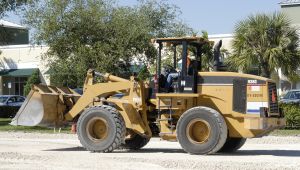An employee at a waste disposal company was killed in what appears to be an industrial accident in Peabody, Massachusetts, according to a recent news article from the Eagle Tribune.
 Authorities say victim was working a Friday morning shift when he was run over by a front-loader. The accident occurred at the waste management facility just north of Route 1. After being struck, victim was not breathing and had no pulse. He died only minutes after being struck. Police declined to give more specifics about the injuries, only saying they were very serious and resulted in employee’s work-related death.
Authorities say victim was working a Friday morning shift when he was run over by a front-loader. The accident occurred at the waste management facility just north of Route 1. After being struck, victim was not breathing and had no pulse. He died only minutes after being struck. Police declined to give more specifics about the injuries, only saying they were very serious and resulted in employee’s work-related death.
While Massachusetts police and the United States Occupational Safety and Health Administration (OSHA) continue to investigate this fatal industrial accident, the district attorney has stated that it appears to be purely an accident and does not plan to file any criminal charges against the employer or driver of the front-loader.
Continue reading
 Massachusetts Workers Compensation Lawyers Blog
Massachusetts Workers Compensation Lawyers Blog




 After reaching this settlement, plaintiff filed a wrongful death civil lawsuit against employer and obtained a default judgment in the amount of $9.525 million in damages. After the default judgment was entered, employer refused to pay the judgment. At this point, plaintiff sued employer again in state court, alleging employer breached its agreement under their liability policy. Employer had the case removed to federal court.
After reaching this settlement, plaintiff filed a wrongful death civil lawsuit against employer and obtained a default judgment in the amount of $9.525 million in damages. After the default judgment was entered, employer refused to pay the judgment. At this point, plaintiff sued employer again in state court, alleging employer breached its agreement under their liability policy. Employer had the case removed to federal court. A year later, when claimant was using a power auger to clear a kitchen sink drain in a hotel, her right glove became caught in the auger and crushed her wrist and hand. Doctors initially diagnosed claimant with a hand sprain and two finger sprains and bruises. She was eventually cleared to return to work full time, but her supervisor felt she was not physically capable of performing the work in the manner she could before the on-the-job injury.
A year later, when claimant was using a power auger to clear a kitchen sink drain in a hotel, her right glove became caught in the auger and crushed her wrist and hand. Doctors initially diagnosed claimant with a hand sprain and two finger sprains and bruises. She was eventually cleared to return to work full time, but her supervisor felt she was not physically capable of performing the work in the manner she could before the on-the-job injury.



 According to a recent news release from the United States Occupational Safety and Health Administration (
According to a recent news release from the United States Occupational Safety and Health Administration ( X-rays of her hand were negative for physical injuries and a head CT scan showed no abnormalities. Her doctor stated that she had nearly fully recovered but recommended continued physical therapy. After completing physical therapy, she had made a significant recovery from her injuries, according to her PCP.
X-rays of her hand were negative for physical injuries and a head CT scan showed no abnormalities. Her doctor stated that she had nearly fully recovered but recommended continued physical therapy. After completing physical therapy, she had made a significant recovery from her injuries, according to her PCP. Claimant slipped on a wet floor at the medical center and seriously injured her right leg, hip, lower back, and neck. She quickly applied for workers’ compensation benefits and was awarded around $580 per week as the maximum allowable benefit under a temporary total disability rating. This happened in 2006.
Claimant slipped on a wet floor at the medical center and seriously injured her right leg, hip, lower back, and neck. She quickly applied for workers’ compensation benefits and was awarded around $580 per week as the maximum allowable benefit under a temporary total disability rating. This happened in 2006.